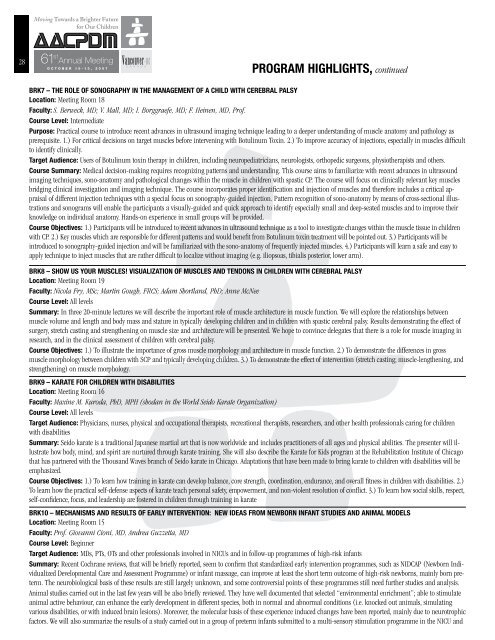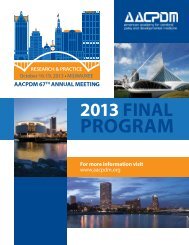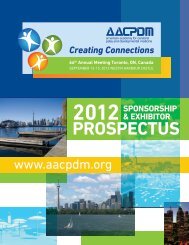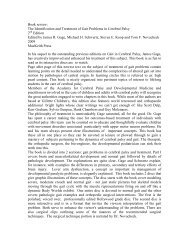Final Program - American Academy for Cerebral Palsy and ...
Final Program - American Academy for Cerebral Palsy and ...
Final Program - American Academy for Cerebral Palsy and ...
You also want an ePaper? Increase the reach of your titles
YUMPU automatically turns print PDFs into web optimized ePapers that Google loves.
28<br />
<strong>Program</strong> HigHligHTs, continued<br />
brk7 – THe role of sonograPHy in THe managemenT of a CHild WiTH <strong>Cerebral</strong> <strong>Palsy</strong><br />
location: Meeting Room 8<br />
faculty: S. Berweck, MD; V. Mall, MD; I. Borggraefe, MD; F. Heinen, MD, Prof.<br />
Course level: Intermediate<br />
Purpose: Practical course to introduce recent advances in ultrasound imaging technique leading to a deeper underst<strong>and</strong>ing of muscle anatomy <strong>and</strong> pathology as<br />
prerequisite . .) For critical decisions on target muscles be<strong>for</strong>e intervening with Botulinum Toxin . 2 .) To improve accuracy of injections, especially in muscles difficult<br />
to identify clinically .<br />
Target audience: Users of Botulinum toxin therapy in children, including neuropediatricians, neurologists, orthopedic surgeons, physiotherapists <strong>and</strong> others .<br />
Course summary: Medical decision-making requires recognizing patterns <strong>and</strong> underst<strong>and</strong>ing . This course aims to familiarize with recent advances in ultrasound<br />
imaging techniques, sono-anatomy <strong>and</strong> pathological changes within the muscle in children with spastic CP . The course will focus on clinically relevant key muscles<br />
bridging clinical investigation <strong>and</strong> imaging technique . The course incorporates proper identification <strong>and</strong> injection of muscles <strong>and</strong> there<strong>for</strong>e includes a critical appraisal<br />
of different injection techniques with a special focus on sonography-guided injection . Pattern recognition of sono-anatomy by means of cross-sectional illustrations<br />
<strong>and</strong> sonograms will enable the participants a visually-guided <strong>and</strong> quick approach to identify especially small <strong>and</strong> deep-seated muscles <strong>and</strong> to improve their<br />
knowledge on individual anatomy . H<strong>and</strong>s-on experience in small groups will be provided .<br />
Course objectives: .) Participants will be introduced to recent advances in ultrasound technique as a tool to investigate changes within the muscle tissue in children<br />
with CP . 2 .) Key muscles which are responsible <strong>for</strong> different patterns <strong>and</strong> would benefit from Botulinum toxin treatment will be pointed out . 3 .) Participants will be<br />
introduced to sonography-guided injection <strong>and</strong> will be familiarized with the sono-anatomy of frequently injected muscles . 4 .) Participants will learn a safe <strong>and</strong> easy to<br />
apply technique to inject muscles that are rather difficult to localize without imaging (e .g . iliopsoas, tibialis posterior, lower arm) .<br />
brk8 – sHoW us your musCles! visualiZaTion of musCles <strong>and</strong> Tendons in CHildren WiTH <strong>Cerebral</strong> <strong>Palsy</strong><br />
location: Meeting Room 9<br />
faculty: Nicola Fry, MSc; Martin Gough, FRCS; Adam Shortl<strong>and</strong>, PhD; Anne McNee<br />
Course level: All levels<br />
summary: In three 20-minute lectures we will describe the important role of muscle architecture in muscle function . We will explore the relationships between<br />
muscle volume <strong>and</strong> length <strong>and</strong> body mass <strong>and</strong> stature in typically developing children <strong>and</strong> in children with spastic cerebral palsy . Results demonstrating the effect of<br />
surgery, stretch casting <strong>and</strong> strengthening on muscle size <strong>and</strong> architecture will be presented . We hope to convince delegates that there is a role <strong>for</strong> muscle imaging in<br />
research, <strong>and</strong> in the clinical assessment of children with cerebral palsy .<br />
Course objectives: .) To illustrate the importance of gross muscle morphology <strong>and</strong> architecture in muscle function . 2 .) To demonstrate the differences in gross<br />
muscle morphology between children with SCP <strong>and</strong> typically developing children . 3 .) To demonstrate the effect of intervention (stretch casting; muscle-lengthening, <strong>and</strong><br />
strengthening) on muscle morphology .<br />
brk9 – karaTe <strong>for</strong> CHildren WiTH disabiliTies<br />
location: Meeting Room 6<br />
faculty: Maxine M. Kuroda, PhD, MPH (shodan in the World Seido Karate Organization)<br />
Course level: All levels<br />
Target audience: Physicians, nurses, physical <strong>and</strong> occupational therapists, recreational therapists, researchers, <strong>and</strong> other health professionals caring <strong>for</strong> children<br />
with disabilities<br />
summary: Seido karate is a traditional Japanese martial art that is now worldwide <strong>and</strong> includes practitioners of all ages <strong>and</strong> physical abilities . The presenter will illustrate<br />
how body, mind, <strong>and</strong> spirit are nurtured through karate training . She will also describe the Karate <strong>for</strong> Kids program at the Rehabilitation Institute of Chicago<br />
that has partnered with the Thous<strong>and</strong> Waves branch of Seido karate in Chicago . Adaptations that have been made to bring karate to children with disabilities will be<br />
emphasized .<br />
Course objectives: .) To learn how training in karate can develop balance, core strength, coordination, endurance, <strong>and</strong> overall fitness in children with disabilities . 2 .)<br />
To learn how the practical self-defense aspects of karate teach personal safety, empowerment, <strong>and</strong> non-violent resolution of conflict . 3 .) To learn how social skills, respect,<br />
self-confidence, focus, <strong>and</strong> leadership are fostered in children through training in karate<br />
brk10 – meCHanisms <strong>and</strong> resulTs of early inTervenTion: neW ideas from neWborn infanT sTudies <strong>and</strong> animal models<br />
location: Meeting Room 5<br />
faculty: Prof. Giovanni Cioni, MD, Andrea Guzzetta, MD<br />
Course level: Beginner<br />
Target audience: MDs, PTs, OTs <strong>and</strong> other professionals involved in NICUs <strong>and</strong> in follow-up programmes of high-risk infants<br />
summary: Recent Cochrane reviews, that will be briefly reported, seem to confirm that st<strong>and</strong>ardized early intervention programmes, such as NIDCAP (Newborn Individualized<br />
Developmental Care <strong>and</strong> Assessment <strong>Program</strong>me) or infant massage, can improve at least the short term outcome of high-risk newborns, mainly born preterm<br />
. The neurobiological basis of these results are still largely unknown, <strong>and</strong> some controversial points of these programmes still need further studies <strong>and</strong> analysis .<br />
Animal studies carried out in the last few years will be also briefly reviewed . They have well documented that selected “environmental enrichment”; able to stimulate<br />
animal active behaviour, can enhance the early development in different species, both in normal <strong>and</strong> abnormal conditions (i .e . knocked out animals, simulating<br />
various disabilities, or with induced brain lesions) . Moreover, the molecular basis of these experience induced changes have been reported, mainly due to neurotrophic<br />
factors . We will also summarize the results of a study carried out in a group of preterm infants submitted to a multi-sensory stimulation programme in the NICU <strong>and</strong>







